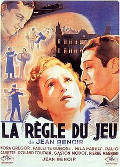
France 1939
Directed by
Jean Renoir
110 minutes
Rated PG
Reviewed by
Bernard Hemingway

Regle du Jeu, La
Many, film-makers and critic in particular, regard Jean Renoir’s upstairs/downstairs comedy set in the immediate pre-WWII era as a masterpiece, both camps showering it with fulsome, near-hysterical praise. I'm not so sure. Yes, it is technically a polished film for its day, the most expensive French film up to that time 9largely due to over-runs), with Renoir and cinematographer Jean Bachelet making use of deep-focus lenses and long shots during which the camera is constantly moving, at the time both sophisticated cinematic techniques and there is the resonant centrepiece of a hunting scene in which, aided by their obliging servants, the toffs witlessly massacre game but dramatically it’s all rather schematic, its farcical elements are dated (it was banned by the wartime French government for "having an undesirable influence over the young") and overlong and the unconvincing denouement comes too quickly and conveniently.
Celebrity aviator André (Roland Toutain) is in love with Christine (Nora Gregor) whose aristocratic husband, Robert, the Marquis de la Chesnaye (Marcel Dalio) is himself hiding a mistress Geneviève (Mila Parély). Octave (Renoir) is a cheery bachelor who moves freely amongst this circle who, in the main section of the film, all go to Robert’s country estate, La Colinière, in Sologne for a hunting party. There, Christine's married maid, Lisette (Paulette Dubost), flirts with the local poacher, Marceau (Julien Carette), much to the displeasure of her game-keeper husband, Schumacher (Gaston Modot).
More a comedy of manners than a satire, La Règle du Jeu doesn’t have the sting of Bunuel's indictment of the bourgeoisie, the class hierarchy it portrays being long since gone (not inherently a problem as Stephen Frears demonstrated with Dangerous Liaisons but he had Francois Choderlos de Laclos' original text to work from) and the farcical elements, which largely revolve around the antipathy between Schumacher and Marceau, are Chaplinesque in their slapstick simplicitude. Dated too are the upstairs shenanigans with Dalio made-up like a silent era Lothario and Renoir’s Octave an inexplicable presence, friend and counsel to everyone but why or how this came to be is never evident. The film’s resolution, which depends on he and Christine declaring their love for each other is as flimsy a plot device as you’re ever likely to come across.
Somewhat surprisingly, despite the fact that Renoir had had critical and commercial hits with La Grande Illusion (1937) and La Bête Humaine, (1938) and the film rested squarely on the shoulders of classical French fare (Renoir's initial inspiration was the 1833 play by Alfred de Musset, "Les Caprices de Marianne") it bombed with both sets of audiences. Originally 113 mins it was cut to 100 mins, then to 85 mins after a disastrous premiere. The original print was lost during Allied bombing but it was restored in 1956 under Renoir's guidance and has been riding high in the critical pantheon ever since.
FYI: To-be famous still photographer Henri Cartier-Bresson worked as an assistant on the film.
Want something different?





